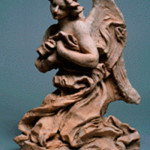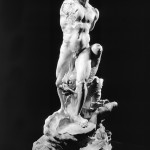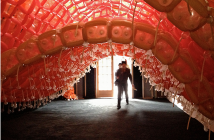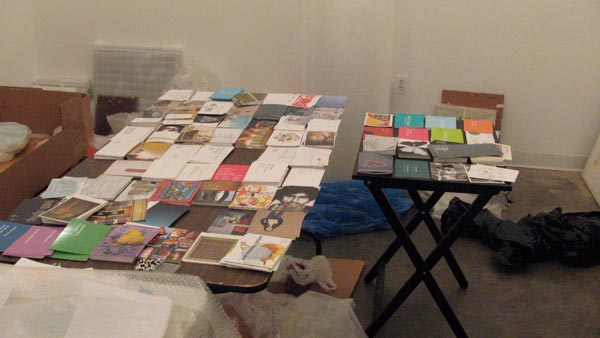By Karen Schiff
One fine morning at the Harvard Art Museums, at about this time last year, I poked into the Fogg's ongoing Bernini exhibition, mounted in a cozy room to the left of the entrance. I wanted to check out the famous old master's works in person. I was surprised to encounter tiny, fresh sculptures -- more on these in a moment -- but what stunned me the most was finding a small Gerhard Richter painting, hanging in a dark back corner. Hah! What was that doing here?
Surely it couldn't be a mistake...?! No; its placement looked deliberate, and it even had its own wall text. Still, why would a late-twentieth-century painting be hanging -- lurking, no less -- behind a roomful of seventeenth-century maquettes? This was an odd twist on the mythology about museums, in which neglected treasures from bygone eras can get discovered in dusty storage areas. Here was a thoroughly contemporary work, "hidden" in plain sight! And its position and lighting made it seem hidden, indeed; I could easily have missed it altogether.
To miss this Richter, however, is to miss the best of the Bernini exhibition. By this I do not mean that I think Richter is a better artist than Bernini, nor that we "contemporary people" would do best to look at recent artworks. I mean that my experience of the maquettes was heightened, and brightened, by having contemplated the Richter. The painting provided a more provocative counterpoint to the clay sculptures than the two ancient Greek sculptures that were also displayed in the room (flanking the entrance, so that looking back across the space felt as if I was standing in a compressed timeline of art history). The Richter made me see this exhibition as being not just about Bernini, or sculptures, or old masters. It was an exploration of mortal efforts toward mastery.
The show's thematic subtitle, Sketches in Clay, already indicates the striving quality of the works on display. The production is generally rough, as befits "unfinished" works. According to the wall text and a fine catalogue essay -- both written by the exhibition's primary curator, Ivan Gaskell -- Bernini and his contemporaries often made these small sculptures to guide the fabrication of full-sized clay models that would later get cast in bronze or carved in marble. The maquettes were also used to think through formal questions of aesthetics and mechanics: I particularly enjoyed looking at two versions of the same angel, presented side by side. The angels are similarly sized and structured, right down to the same basic folds in their robes, but the clay is manipulated afresh; no detail seems "copied" from one to the other. The overall affect of the works, too, seems uniquely conceived (but by the same mind) in each case. In all these "sketches," tone is created through technique. The clay bears the traces of having been planed by smooth tools, raked over by toothed tools, and poked with fingers, though some of the modeling on the figures is so fine that it is as if no instrument has touched their flesh.
Richter's 1972 painting, Overpainting (Brown), offers a corresponding combination of gritty power and subtle aestheticism. The pigment glistens with oil and curls out from the surface, in the wake of the artist's tool having slashed quickly and repeatedly across the canvas. The painting has the palette of dirt: burnt umber with lighter ochres showing through. The paint is in fact created with earth pigment, so it is possible to perceive a continuous thread of medium from one era to the other. (A meditation on clay as an eternal and human medium is furthered by the quotations inscribed on the walls of the gallery.) Its strokes are confident, and in this regard the painting is a strong match for Bernini's models.
But the Richter doesn't blow your mind with its strength, nor do its lessons hit you over the head. They enter through the back door, by confounding your expectations and then making you chuckle and crow. For instance, the wall text revealed that Overpainting (Brown) is part of a group of 120 such pieces, made at one time as a single work and then distributed around the world. I began to think about a global network of Richter paintings, perhaps impossible to assemble yet titillating to imagine. When I turned around to face the clay sculptures again, I saw these, too, as part of a larger set. Who knows where other Bernini maquettes might be, and what obstacles might prevent theirassembly? Any museum exhibition was resisting the entropic drift of objects over time... And my sphere of awareness suddenly had expanded, from being stuck in the small room to encompassing the planet. Amazing what one little painting could do! Hah!
Unfortunately, dear Reader, the Richter is no longer lurking in the gallery. Last fall, the exhibition got rearranged, and all the non-seventeenth-century items removed, to make space for a larger model to be shown in the middle. Harvard had done some conservation work on a large maquette for Bernini's sculpture, Fountain of the Moor, for the Kimbell Art Museum in Fort Worth. Before sending it back, the Fogg created an opportunity to showcase The Moor amidst other models from its original context. But because of its size, it needed elbow room... Exit Richter. Winter came, and The Moor went back south, but the room stayed seventeenth-century.
The difference in the exhibition is palpable. Without the classical and contemporary artworks, the maquettes become slightly stale: they sit as examples of a distant abstraction such as "masterful work" or "Bernini-ness." Though this was what had brought me into the exhibition in the first place, it is a tired approach and it stains museum-going with duty and drudgery. In the version of the exhibition that is currently on view, the maquettes threaten to become dried-up things in vitrines, nouns plopped down, instead of wildly dynamic experiments. Seen next to Richter's impassioned plowings through paint, on the other hand, the baroque models were engaged in activity. They were verbs, not nouns. Bernini dove into clay with dedicated fervor, open to possibility and not caring about our categories of art-historical import.
And so the Sketches in Clay remain. The raw excellence of these sculptures explains why they have been on view for ten years... and this is your last chance to see them for a while. The exhibition ends on June 30th. I hope this article can fill in where the Richter has been left out, so you can carry its memory with you when you are looking at the sculptures. (I am not including an image of the painting here; the only one available online is reproduced in black and white and on the restricted Harvard website. If you wish, you may search it in the "Research Resources" section of the link below.) Certainly I have often gotten a jolt of good cheer, just to remember this quirk of intelligence winking in a corner of the Fogg.
- Gian Lorenzo Bernini, Kneeling Angel, Terracotta, 1673.
- Gian Lorenzo Bernini, Model of the “Moor,”, Terracotta, c. 1653.
"Gian Lorenzo Bernini: Sketches in Clay" is on view February 28, 1998 - June 30, 2008 at the Fogg Art Museum of the Harvard Art Museums.
"Kneeling Angel" image courtesy of the Harvard Art Museums.
"Model of the Moor" image courtesy of the Kimbell Art Museum (found via Google)






